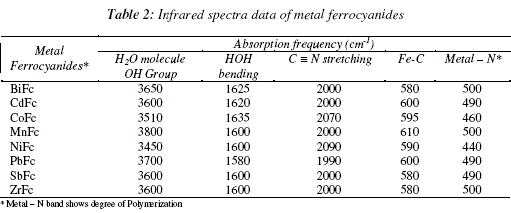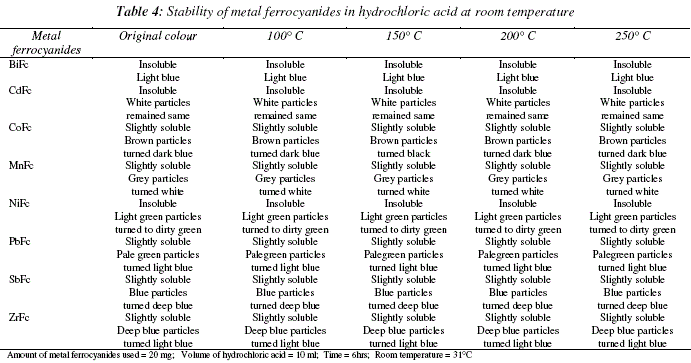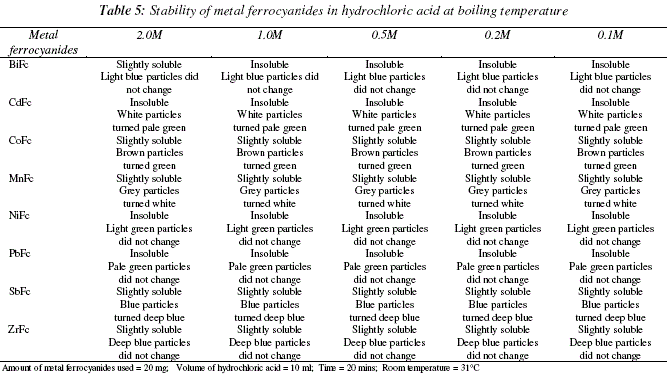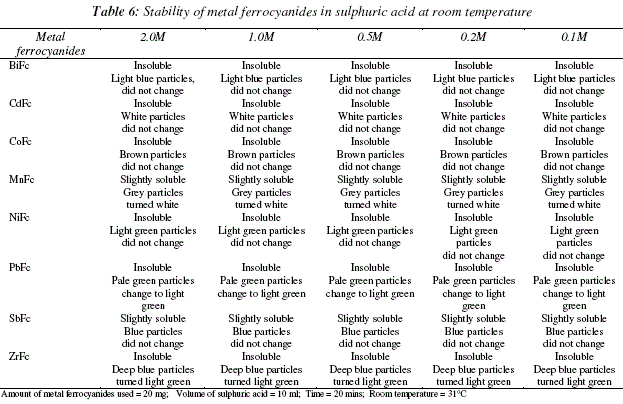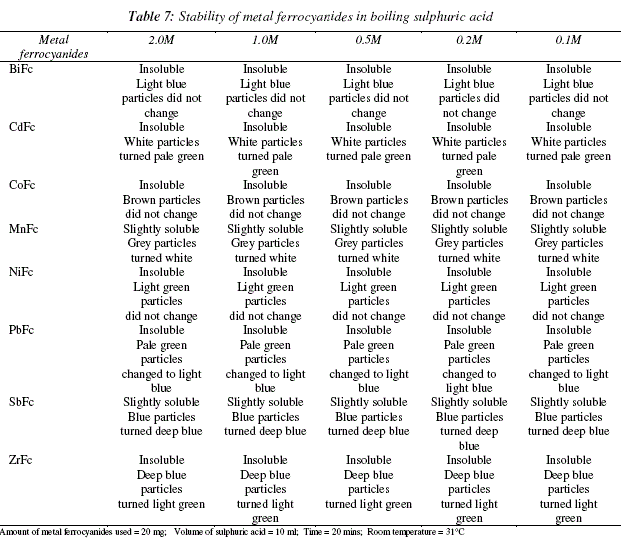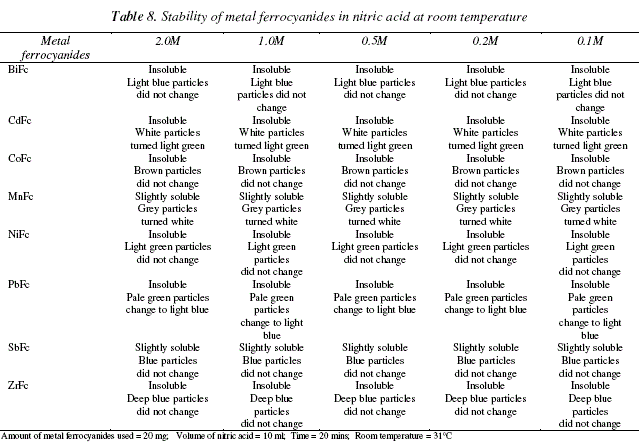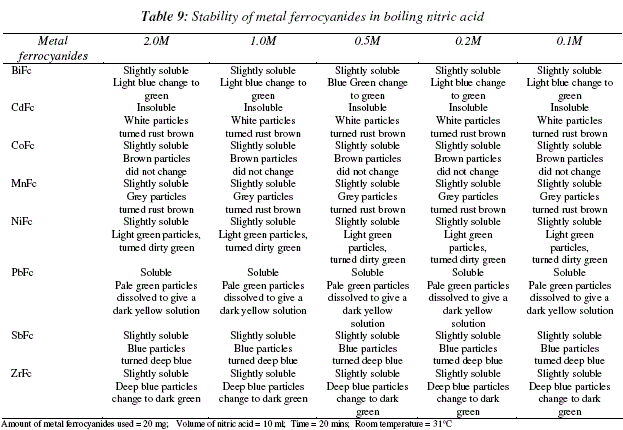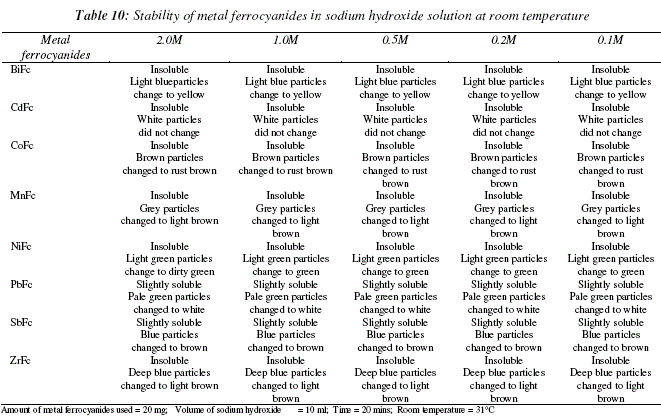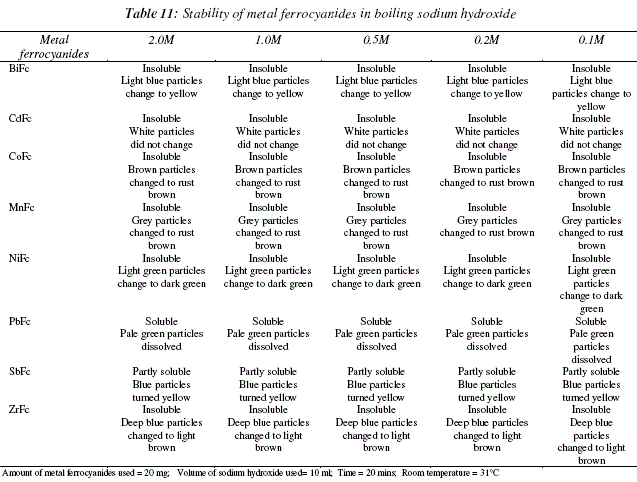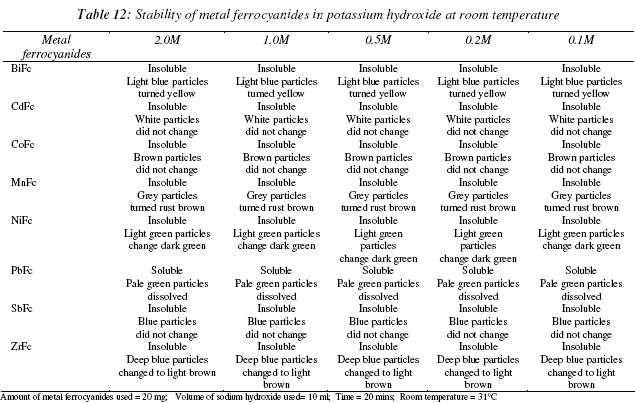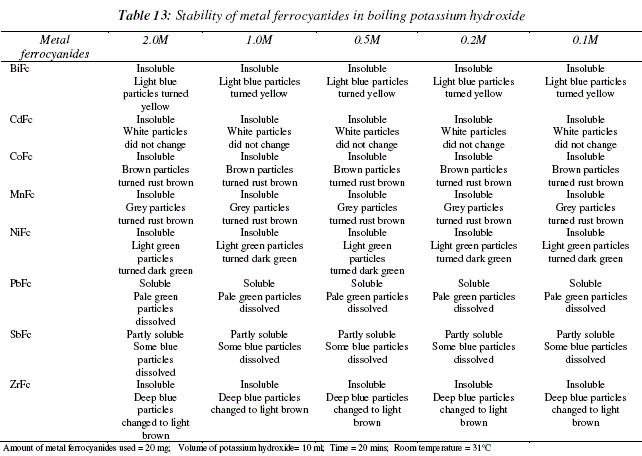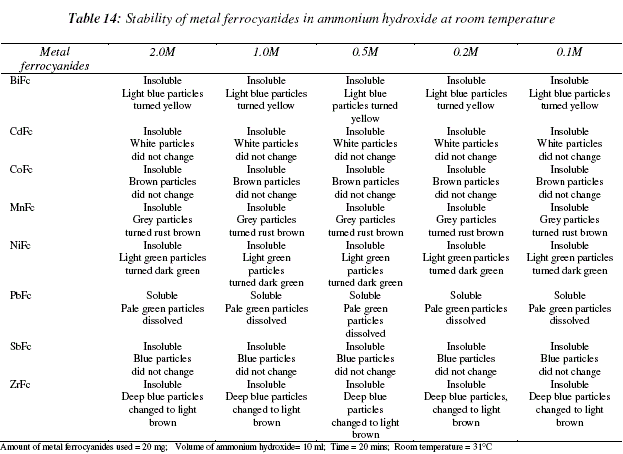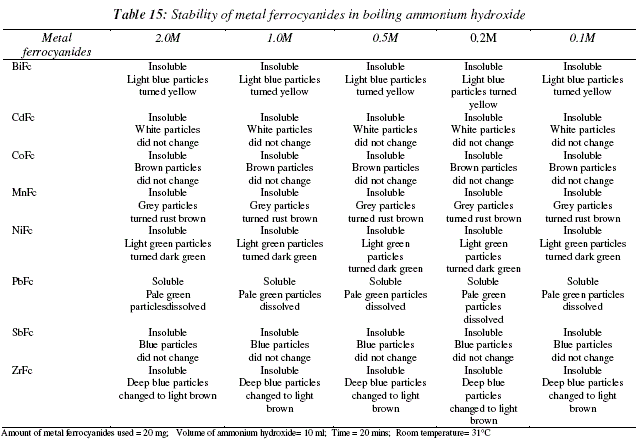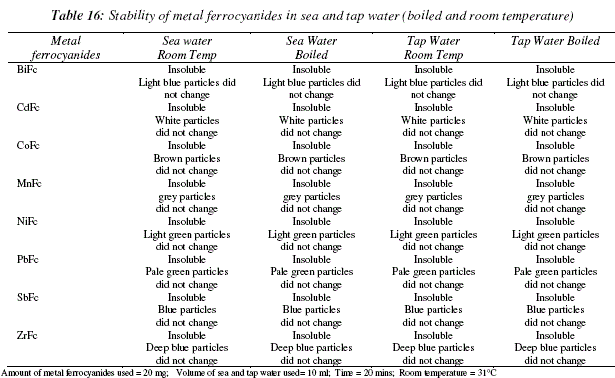Revista Boliviana de Química
versión On-line ISSN 0250-5460
Rev. Bol. Quim vol.33 no.1 La Paz abr. 2016
ARTICULOS ORIGINALES
Critical reviews on stability and photosensitizer potential of metal
hexacyanoferrate (II) complexes: A possible prebiotic mineral
Brij B. Tewari1*, Clint O. Thornton1, Naeem Hamid1, Ashish K. Tiwari2,3, Marc V. Boodhoo4
*Corresponding author: brijtewari2011@yahoo.com
Abstract
Bismuth, cadmium, cobalt, manganese, nickel, lead, antimony and zirconium hexacyanoferrate (II) complexes or metal ferrocyanides were synthesized and characterized by elemental and spectral studies. Stability of metal hexacyanoferrate (II) complexes were recorded in heat, light (UV, VIS), different concentrations of various acids (HCl, H2SO4, HNO3), different concentration of various bases (NaOH, KOH, NH4OH), sea and tap water.The photosensitizing activity of metal hexacyanoferrate (II) complexes were tested by using potassium iodide and starch solution. Nickel, antimony and zirconium ferrocyanides were found to be possible photosensitizer during the course of chemical evolution on primitive Earth.
Keywords: Metal hexacyanoferrate (II) complexes, Synthesis, Stability, Oxidizer, photosensitizer
Resumen
Spanish title; Revisiones críticas sobre la estabilidad y el potencial fotosensibilizante de complejos metálicos de hexacianoferrato (II): un posible mineral prebiótico. Los complejos de hexacianoferrato (II) o ferrocianuros metálicos de bismuto, cadmio, cobalto, manganeso, níquel, plomo, antimonio y zirconio fueron sintetizados y caracterizados por estudios espectrales elementales. La estabilidad de los complejos metálicos de hexacianoferrato (II) fue registrada bajo condiciones de calor, luz (UV, VIS), diferentes concentraciones de varios ácidos (HCl, H2SO4, HNO3), diferentes concentraciones de varias bases (NaOH, KOH, NH4OH), y agua de mar y agua potable. La actividad fotosensibilizadora de los complejos metálicos fue probada mediante el uso de yoduro de potasio y solución de almidón. Los ferrocianuros de niquel, antimonio y zirconio fueron determinados como posibles fotosensibilizadores durante el curso de la evolución química en la era terrestre primitiva.
INTRODUCTION
Due to the ease of formation of cyanide ions under prebiotic conditions, it is thought that cyanide may have formed stable complexes with abundant transition metal ions present in the primeval seas. The primitive Earth was anoxygenic and its reducing potential was not high enough hence most metals were present in their lower oxidation states. It is further assumed that during the course of chemical evolution, cyanide may also have formed some insoluble double metal ferrocyanides of general formula M2 [Fe (CN)6] x H2O, where M can be Cd, Sb, Zn, Bi, Cu, Mo etc. The double metal ferrocyanides are insoluble in water and are considered to have settled to the bottom of the primeval sea and acted as active surfaces for the condensation of amino acids nucleic acids, sugars etc. [1]. It is assumed that chemical evolution took place in the primeval sea and their presence was probable. The occurrence of ferri-ferrocyanide in the anoxic Archaean hydrosphere lends support to this hypothesis [2] .It is believed that photocatalytic activity by inorganic minerals could have been very pronounced on the primitive Earth. The oxides of titanium, zinc and tungsten possess high photosensitizing activity comparable with the activity of porphyrins and chlorophylls. These compounds are able to sensitize reactions accompanied by light energy storage in terminal stable products [3, 4]. It is well established that metal ferrocyanides act as adsorbents [5-7] ion exchangers [8-11] and photosensitizers [12, 13]. Stability of double metal ferrocyanides in the primeval seas may possibly have played a significant role in the protection and condensation of bioorganic molecules during course of chemical evolution on primitive Earth.
A search in the literature indicated some reports available on synthesis of metal ferrocyanides and very few information available on stability and photosensitizing activity of metal ferrocyanides. In view of this, the attempt was made to study stability and photosensitizing activity of bismuth, cadmium, cobalt, manganese, nickel, lead, antimony and zirconium ferrocyanides.In addition, the present work describes a review on stability and photosensitizing activity of metal ferrocyanides.
RESULTS AND DISCUSSION
Elemental analysis and spectral studies of metal ferrocyanides
The percentage composition of metals in metal ferrocyanides are given in Table 1. The percentage of metals (bismuth, cadmium, cobalt, manganese, nickel, lead, antimony, zirconium) are found higher in comparison to iron. Infrared spectral data of metal ferrocyanides are given in Table 2. Absorption frequencies of water molecule and OH groups are found to be higher than HOH bending and C ![]() N stretching frequencies.
N stretching frequencies.
Effects ofheat on the stability of metal ferrocyanides
It is clear from Table 3 that bismuth, manganese, cobalt and cadmium ferrocyanides are found to be stable at 100° C. Antimony and zirconium ferrocyanides are stable to heat at 150° C.
Stability of metal ferrocyanides in various concentrations of acids at room temperature and at boiling temperature
It is observed from Table 4 that ferrocyanides of bismuth, nickel and cadmium are insoluble in various concentrations of hydrochloric acid at room temperature with no change in colour. Ferrocyanides of lead, manganese, cobalt, antimony and zirconium are found to be slightly soluble and unstable in various concentration of HCl at room temperature. Table 5 showed that ferrocyanides of nickel, cadmium and lead are insoluble in various concentrations of boiled hydrochloric acid, and they were found to be stable too. Ferrocyanides of cobalt, antimony, zirconium, bismuth and ferrocyanide of manganese are found to be slightly soluble and unstable in various concentrations of boiled hydrochloric acid.
It is clear from Tables 6 and 7 that ferrocyanides of nickel, cobalt, zirconium, cadmium, lead and bismuth are insoluble and stable while ferrocyanides of manganese and antimony are slightly soluble and unstable in various concentrations of sulphuric acid at room temperature and at boiling temperature.
It is observed from Table 8 that ferrocyanides of bismuth, cadmium, cobalt, nickel, lead and zirconium are found to be insoluble and stable while ferrocyanides of antimony and manganese are found to be slightly soluble and unstable in various concentrations of nitric acid at room temperature.
Table 9 showed that cadmium ferrocyanides is found to be stable and insoluble in comparison to ferrocyanides of bismuth, cobalt, manganese, nickel, lead, antimony and zirconium in various concentrations of nitric acid at boiling temperature. The colour changes of metal ferrocyanides may be due to electronic transition in the molecules of the solid metal ferrocyanides.
Stability of metal ferrocyanides in various concentration of bases at room and boil temperature
It is clear from Table 10 that ferrocyanides of bismuth, cadmium, cobalt, manganese, nickel, and zirconium are insoluble and stable while ferrocyanides of antimony and lead are slightly soluble and unstable in various concentrations of sodium hydroxide at room temperature. Table 11 indicated that ferrocyanides of bismuth, cadmium, cobalt, nickel, manganese and zirconium are found to be insoluble and stable while ferrocyanides of antimony and lead are soluble and unstable in various concentration of sodium hydroxide at boiling temperature. It is observed from Tables 12 and 13 that ferrocyanides of bismuth, cadmium, cobalt, manganese, nickel and zirconium are insoluble and stable while lead ferrocyanides is soluble and unstable in various concentrations of potassium hydroxide at room temperature and at boiling temperatures. Antimony ferrocyanide is insoluble and stable at room temperature while it's partly soluble and unstable at boil temperature of KOH. It is clear from Tables 14 and 15 that ferrocyanides of bismuth, cadmium, cobalt, manganese, nickel, antimony and zirconium ferrocyanide, are insoluble and stable while lead ferrocyanides is soluble and unstable in various concentrations of ammonium hydroxide at room temperature and at boil temperatures. The colour change of metal ferrocyanide is mainly due to electronic transition within metal ferrocyanide molecules.
Stability of metal ferrocyanides in tap water and sea water at room and boiling temperature
Table 16 showed that all metal ferrocyanides are found to be insoluble and stable in the tap water and sea (Atlantic Ocean) water at room and boil temperature. This study supports the hypothesis that metal ferrocyanides are possible insoluble and stable during the course of chemical evolution on primitive Earth. They also play important roles in protection and condensation of bioorganic molecules during the course of chemical evolution in primeval seas.
Effect oflight (UV/VIS) on the stability of metal ferrocyanides
It is clear from Tables 17 and 18 that ferrocyanides of antimony, cadmium and zirconium are stable in visible and ultra violet light un til 48 hrs of radiation. Ferrocyanides of bismuth and manganese are found to be stable until 12 hrs in vis and uv light. Ferrocyanides of nickel, cobalt and lead are unstable in visible light at 12, 24, 36 and 48 hrs in visible and ultra violet light.
Test on oxidizing and photosensitizing activity of metal hexacyanoferrate (II) complexes.
Test on oxidizing and photosensitizing activity of metal ferrocyanide in potassium iodide and starch solution indicated ferrocyanides of nickel, antimony and zirconium as possible photosensitizers; ferrocyanides of lead, manganese, cobalt and cadmium as possible oxidizer and bismuth ferrocyanide as both oxidizer and photosensitizer during the course of chemical evolution on primitive Earth.
CONCLUSION
The following conclusions can be drawn from the present study:
1. The stability of ferrocyanides of bismuth, cadmium, cobalt, manganese, nickel, lead, antimony and zirconium was found to be affected by the presence of heat and light and not affected by the presence of sea and tap water at room temperature and at boiling temperature.
2. Stability of ferrocyanides of bismuth, cadmium, cobalt, manganese, nickel, lead, antimony and zirconium is affected by acids and bases at room temperature and at boiling temperature.
3. It was found that ferrocyanides of nickel, antimony and zirconium are possible photosensitizers and that ferrocyanides of lead, manganese, cobalt and cadmium are possible oxidizers during the course of chemical evolution and the origins of life on the primitive Earth.
4. It is also concluded from present study that double metal ferrocyanides are insoluble and stable during the course of chemical evolution on primitive Earth and play significant role in condensation of precursors of early life in primeval seas.
EXPERIMENTAL
Materials
All chemicals used were of AnalaR grade. Potassium ferrocyanide, antimony(II) chloride, cadmium (II) chloride, zirconyl chloride, bismuth (II) chloride, lead(II) chloride, manganese(II) chloride, cobalt(II) chloride, nickel(II) chloride were obtained from BDH Poole, England. All chemicals used without further purification. Solutions were prepared in doubly distilled water.
Synthesis of metal hexacyanoferrate (II) complexes
Metal (bismuth, cadmium, manganese, nickel, lead, antimony and zirconium) hexacyanoferrate (II) complexes were prepared according to method reported by Kourim [14]. Metal hexacyanoferrate (II) complexes were prepared by adding metal chloride (500 ml, 0.1 M) and potassium ferrocyanide (167 ml, 0.1 M) solutions with constant stirring. The reaction mixture was heated on a water bath for 3h and kept as such at room temperature. The precipitate was filtered under vacuum, washed several times with distilled water and dried in an air oven at 60C. The dried product was grounded and sieved to 125 ¡am particle size.
Cobalt ferrocyanide was synthesized by adding (1 volume, 0.5 M) potassium ferrocyanide and (2.4 volume, 0.3 M) cobalt chloride and kept as such after gently stirring over a period of 30 min at room temperature [15]. The slurry of cobalt ferrocyanide was filtered under vacuum, washed several times with distilled water and dried. The resulting granules were dried and powdered to 125 ¡am particle size.
Characteristics of metal ferrocyanides
Bismuth, cadmium, cobalt, manganese, nickel, lead, antimony and zirconium ferrocyanides are light blue, white, brown, grey, light green, pale green, blue, and deep blue colours, respectively. These metal ferrocyanides are amorphous insoluble solid and showed no x-ray pattern.
The metal ferrocyanides were characterized on the basis of elemental and spectral studies. The percentage composition of metals was determined by IL - 751 atomic adsorption spectrophotometer [16]. Carbon, hydrogen and nitrogen analysis were carried out by CEST - 118, CHN analyzer. Percentage composition of elements in metal ferrocyanides are given in Table 1.
Infrared spectra of the metal ferrocyanides were recorded in KBr disc on Beckman IR-20 spectrophotometer. All eight metal ferrocyanides show at broad peak at 3450 - 3700 cm-1 is characteristics of water molecule and OH group. Also a peak at around 1580 - 1635 cm-1 is due to HOH bending. Two sharp peaks, one at 1990 - 2070 cm-1 and the other at 580 - 610 cm-1 in all metal ferrocyanides are characteristics of cyanide stretching and Fe-C stretching frequencies, respectively [17]. Another sharp band at 440-500 cm-1 in all metal ferrocyanides probably shows the presence of metal - nitrogen bond thus indicating a certain degree of polymerization in the products [18, 19] (Table 2).
Stability study on metal hexacyanoferrate (II) complexes Effect ofheat on the stability of metal ferrocyanide
A 20 mg of each metal ferrocyanides were placed in a petri dish. The Petri dishes were then placed in the air oven for 6 hrs at 100° C. This process was repeated at 150° C, 200° C and 250° C to demonstrate the effect ofheat on the various metal ferrocyanides. The colour of metal ferrocyanides at various temperatures was observed (Table 3)
Stability of metal ferrocyanides in various concentrations ofacids at room and at boiling temperature
The metal ferrocyanides (20 mg) were placed in the test tubes containing 10 ml of each 2.0 M, 1.0 M, 0.5 M and 0.1 M acids (HCl, H2SO4, HNO3).The mixture was agitated for 20 mins at room temperature and observation for any change in colour of metal ferrocyanides was recorded (Tables 4, 6, 8). The same reaction mixture boiled on Bunsen flame for 20 mins and any change in colour of metal ferrocyanides was recorded (Tables 5, 7, 9). This process was repeated for each metal ferrocyanides. The colour change of metal ferrocyanides was recorded.
Stability of metal ferrocyanides in various concentrations of bases at room temperature and at boiling temperature
The metal ferrocyanides (20 mg) were placed in the test tubes containing 10 ml of each 2.0 M, 1.0 M, 0.5 M, 0.1 M bases (NaOH, KOH, NH4OH). The mixture was agitated for 20 minutes at room temperature and observation for any change in colour of metal ferrocyanides was recorded (Tables 10, 12, 14). The same reaction mixture boiled on Bunsen flame for 20 minutes and any change in colour of metal ferrocyanides was recorded (Tables 11, 13, 15). The process is repeated for each metal ferrocyanides. The colour change of metal ferrocyanides was recorded.
Stability of metal ferro cy anides in tap water and sea water at room temperature and at boiling temperature
The metal ferrocyanides (20 mg) were placed in each test tube containing tap water and sea water. The mixture was then agitated for 1h and observation for a change in colour of metal ferrocyanides was recorded (Table 16). The same reaction mixture boiled on Bunsen Flame for 20 mins and change in colour of metal ferrocyanides was recorded (Table 16)
Effect oflight (UV/VIS) on the stability of metal ferrocyanides
A 20 mg of each metal ferrocyanide was placed in a dry Petri dish and the original colour was recorded. A 250 W visible lamp was kept vertically above the sample at a distance of 22 cm. The observations for any change in colour of metal ferrocyanides were recorded at 12, 24, 36 and 48 hrs (Table 17). The same experiment was repeated using a long wave (300-380 nm) ultra violet lamp. The observation of any change in colour of metal ferrocyanides was recorded. (Table 18).
Test on oxidizing and photosensitizing activity of metal hexacyanoferrate (II) complexes.
The oxidizing and photosensitizing capacity of metal hexacyanoferrate (II) complexes were compared by potassium iodide and starch solution. Oxidation of iodide to iodine in presence of starch gives blue colour. One drop of freshly prepared 2.0 % starch solution was added into test tubes (length = 10 cm; internal diameter = 1.30 cm) containing 10 ml of 0.1 M potassium iodide solution. A 25 mg of the metal ferrocyanides were added into each test tube and agitated, observation for any decolourization of blue colour and potassium iodide and starch solution was recorded. The same experiment was repeated using a 250 W, visible lamp, and a long wave UV lamp, which were kept vertically above the test tubes at a distance of 15 cm. Photosensitizers will decolourize the blue colour of potassium iodide and starch solution in the presence of light (-VIS/UV). The oxidizers will decolourize the blue colour of potassium iodide and starch solution in absence of light.
NOTE
- 1 Department of Chemistry, University of Guyana, PO Box: 101110, Georgetown, Guyana, brijtew@yahoo.com
- 2Indian Institute of Technology IIT- Kanpur, Kalyanpur, Kanpur, Uttar Pradesh 208016, Tel: +91 512 259 0151, Kanpur, India
- 3Indian Institute of Technology IIT - Jodhpur, Old Residency Road, Ratanada, Jodhpur, Rajasthan 342011, Tel: +91 291 244 9013, Jodhpur, India
- 4Department of Agriculture Food and Nutritional Sciences, University of Alberta, 410 Agriculture (Forestry Center), Edmonton, AB, T6G 2P5, Canada
REFERENCES
1. Kamaluddin, Nath, M., Deopuzari, S. W., Sharma, A., 1990, Orig. Life Evol. Biosph., 20, 259. [ Links ]
2. Arrhenius, G.,, 4th Symposium on Chemical Evolution and the Origin and Evolution of Life, NASA, Ames Research Centre, Moffet Field, 1990, California, p. 24. [ Links ]
3. Krasnovsky, A. A., Brin, G. P. 1962, DoklAn USSR, 147, 654. [ Links ]
4. Krasnovsky, A. A., Brin, G. P. 1970, Mol. Photonics, Izd. Nauka, 161. [ Links ]
5. Tewari, B. B., 2000, Rev. Anal. Chem., 19, 491. [ Links ]
6. Tewari, B. B., Boodhoo, M. V., 2005, Main Group Metal Chem., 28, 23. [ Links ]
7. Tewari, B. B.,Boodhoo, M. V., 2005, J. Colloid. Interf. Sci., 289, 328. [ Links ]
8. Baetsle, L. H., Van Deyck, D., Huys, D., 1965, J. Inorg. Nucl. Chem., 27, 683. [ Links ]
9. Huys, D., Baetsle, L. H., 1964, J. Inorg. Nucl. Chem., 26, 1329. [ Links ]
10. Amphlett, C. B., Inorganic Ion Exchangers Elsevier, 1964, Amsterdam. [ Links ]
11. Malik, W. U., Srivastava, S. K., Bhandari, V. M., Kumar, S. 1976, J. Inorg. Nucl. Chem., 38, 342. [ Links ]
12. Tewari, B. B. 2005, Rev. Soc. Quim, Peru, 71, 273. [ Links ]
13. Tewari, B. B., Kamaluddin, Proceedings of 83rd Sessions of the Indian Science Congress, 1996, Patiala, India,, p. 34 [ Links ]
14. Kourim, V., Rais, J., Million, B. 1964, J. Inorg. Nucl. Chem., 27, 1111. [ Links ]
15. Prout, W. E., Russell, E. R., Group, H. J. 1965, J. Inorg, Nucl. Chem., 27, 443. [ Links ]
16. Vogel A.I., Vogel,s Text Book of Quantitative Inorganic Analysis,Including Instrumental Analysis, John Wiley & Sons, 4th ed.,1978, New York, p. 827 [ Links ]
17. Nakamoto, K., Infrared Spectra of Inorganic and Coordinate Compounds, John Wiley, 1963, New York, p. 166. [ Links ]
18. Ratnasamy, P., Leonard, A. J. 1976, J. Phys. Chem., 76, 1838. [ Links ]
19. Nakamoto, K., Fujita, J., Murata, H. 1958, J. Am. Chem. Soc., 80, 4817. [ Links ]












 uBio
uBio 

